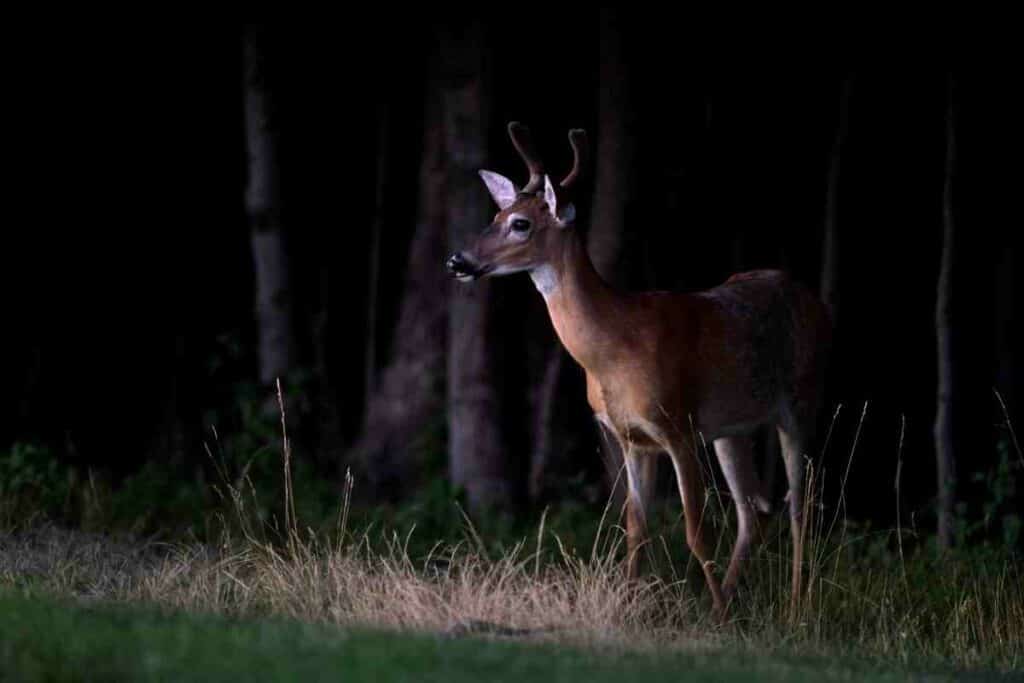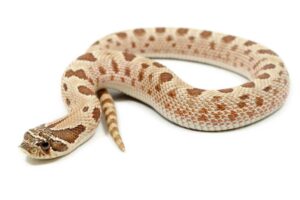When you see a deer in your headlights at night, their eyes seem to virtually glow in the dark, but does this necessarily mean that they can see well in the dark?
Deers eyesight at night time is excellent, roughly 50 times better than a human’s eyesight. When it comes to nighttime vision, deers have what it takes to see well, but otherwise, their vision is not so great. While it seems like their eyesight should be the same regardless of the time of day, this isn’t the case.

As we’ll soon learn, a deer’s eyesight is quite different in the daytime than it is at night.
Table of Contents
What Is Deer Eyesight Like?
Deer have amazing senses of hearing, but their eyesight isn’t great. In fact, if deer were humans, they’d have to wear glasses in order to see properly.
Deer eyes are larger than most mammals, in fact. But they still cannot see well. Let’s take a look at the reasons why.
First of all, humans can read different lines of text and focus on peripheral vision easily. We can even look back and forth at different objects and our eyes stay focused on those objects.
We do this because on our retina is a small area that allows the light to come through the lens. A deer, however, has eyesight that is quite different.
The band of area on the retina that the light comes through is called the visual streak. On a deer, this streak isn’t tall but is very wide.
Because of this, deer can look at things and see objects horizontally, but they are out of focus whenever they look straight ahead. What this means in practical terms is that they don’t have to move their eyes at all when they’re trying to look at an object.
Deer also don’t see longer wavelengths, which means they don’t see a lot of red. Since orange and red are around the same part of the color spectrum, deer don’t see orange well, either, so they hardly notice a hunter’s orange vest.
Shorter wavelength colors are a bit different. Blues, for example, are super-easy for deer to see and in fact, they can see blues better than we do.
Also keep in mind that humans have eyes with UV filters on them, but that isn’t the case with deer.

That means that if a hunter approaches a deer wearing blue jeans and an orange vest, the blue jeans will be immediately noticeable but the vest will look like a subdued color and not a bright one.
When it comes to colors such as yellow, these are considered in the middle of short wavelength and long wavelength colors, so they look neither bright nor dull to deer.
At one time, people thought deer were colorblind, but this is not correct. They can actually see colors very well — better than humans, in fact.
The thing is, their actual vision is not as good as a human’s is because they essentially have only 20/100 vision instead of 20/20 vision. Deer make up for it by using their other senses.
When an animal comes near a deer, they can sense it’s there but they cannot always see it. The only way a deer can see something nearby is if they point their nose up so they can see with both of their eyes, which isn’t always practical for them.
What About Nighttime Vision?
So we’ve determined that deer can see colors better than we can but their overall vision isn’t very good. But at nighttime, all that changes.
It seems odd that deer have rather poor vision during the day but they can see so well at night. If you’re wondering why this is so, there are three main reasons:
- Deer have high-density rods in their eyes.
- Deer have pupils that are slit horizontally, allowing for light to cast on the lens a lot easier.
- Deer have a reflective substance on the back of their eye. It is called the tapetum lucidum.
If you catch the proverbial deer in the headlights, the first thing you’ll notice is that their eyes seem to be glowing back at you.
This is actually the reflection of the back of the deer’s eye. Light will enter the eye then pass over the lens to hit the retina.
Once the light hits the retina, it will bounce back to the front of the eye, then reflect back to the retina once more. Because of this combination of actions, deer have extraordinary night vision.
The whitetail deer, for instance, is able to see 50 times better at night than human beings do.
You can research the facts behind deer eyesight and learn more about how many more rods deer have than humans and how deer have a tapetum lucidum and we don’t, but the important thing to remember is that while their eyesight is not great during the daytime, their nighttime vision is spectacular.
It’s just one of the many interesting facts about deer that many people just don’t know.
Conclusion
Deer have unusually large eyes but their visual streak is wide and not very tall. This allows them to see objects horizontally but they are out of focus when they try to look straight ahead.
Deer essentially don’t even have to move their eyes when they’re looking at an object, thanks to the way their lens and retina are made.
Deer see short wavelength colors such as blue better than longer wavelength colors such as red and orange, so when you wear blue jeans and an orange vest around a deer, it will immediately notice the jeans and barely see the vest.
On the other hand, deer can see at night 50 times better than a human, in part because they have a tapetum lucidum and we do not.
Deer eyesight is simply more accurate when it’s dark outside than it is during the daytime. The inside of the eye works in a rather complex way, and it is those internal components that help deer have great eyesight when it’s dark outside.










